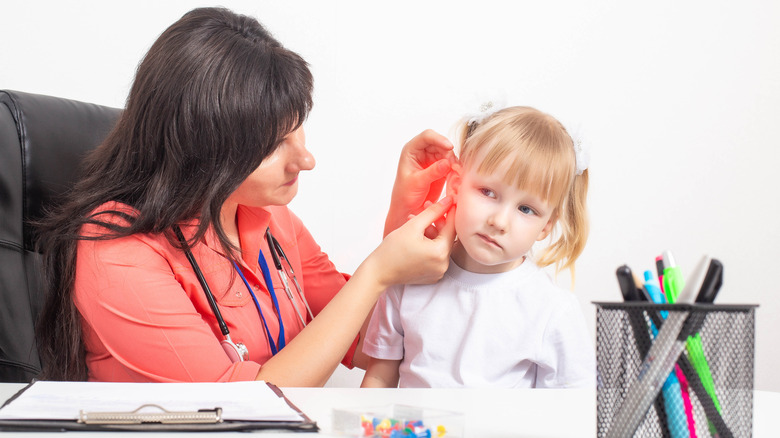The Big Difference Between Swimmer's Ear And An Ear Infection
According to the Centers for Disease Control and Prevention (CDC), while swimmer's ear and ear infections are both based in the ear, they are distinct issues with distinct causes.
Swimmer's ear — also known as otitis externa — is a bacterial infection that arises in the outer ear canal. Swimmer's ear typically occurs when water rests in the outer ear canal for an extended period, creating moist conditions that are conducive to the growth of bacteria. Symptoms of swimmer's ear can include pain in the outer ear when it is tugged or experiences pressure, an itchy feeling inside the ear, drainage from the ear, or redness and swelling.
Unlike swimmer's ear, an ear infection affects the middle ear rather than the outer ear canal (via CDC). Children are more likely than adults to get middle ear infections, which are typically caused by either bacteria or viruses like the common cold or flu. Symptoms of an ear infection can include pain in the ear, fever, irritability, and sleeping issues, among others.
Treatment options for swimmer's ear and ear infections
When treating swimmer's ear, the aim is to halt the infection so the ear can begin to heal. According to Mayo Clinic, doctors will often prescribe ear drops that contain one or more ingredients, depending on the seriousness of the infections. For example, these ingredients could include steroids to reduce inflammation, antibiotics, or anti-fungal medication. If your ear canal is completely blocked due to swelling or inflammation, your health provider may treat this issue by inserting a wick of cotton or gauze to expedite the drainage and aid the routing of the medication into your ear. If your swimmer's ear is causing you pain, your doctor may suggest that you take an over-the-counter pain reliever such as ibuprofen, naproxen sodium or acetaminophen. The CDC also advises that you avoid swimming or flying and protect your ear while showering or bathing until you recover.
As to ear infections, Mayo Clinic states that these can sometimes resolve on their own without antibiotics. If your child has an ear infection, the best method will often depend on factors such as their age and the severity of the symptoms, but pediatric experts often suggest a wait-and-see approach as a place to start since symptoms typically begin to improve within the first few days and clear up entirely in a couple of weeks.


